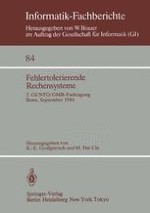In the last decade of Computer Science development, we can observe a growing interest in fault-tolerant computing. This interest is the result of a rising number of appl'ications where reliable operation of computing systems is an essential requirement. Besides basic research in the field of fault-tolerant computing, there is an increasing num ber of systems especially designed to achieve fault-tolerance. It is the objective of this conference to offer a survey of present research and development activities in these areas. The second GI/NTG/GM~ Conference on Fault-Tolerant Computing Systems has had a preparatory time of about two years. In March 1982, the first GI conference concerning fault-tolerant computing systems was held in Munich. One of the results of the conference was to bring an organiza tional framework to the FTC community in Germany. This led to the founding of the common interest group "Fault-Tolerant Computing Systems" of the Gesellschaft fur Informatik (GI), the Nachrichtentechnische Gesellschaft (NTG), and the Gesellschaft fur MeB- und Regelungstechnik (VDI/VDE-GMR) in November 1982. At that time, it was also decided to schedule a biannual conference on fault-tolerant computing systems. One of the goals of this second conference is to strengthen the relations with the international FTC community; thus, the call for papers was extended not only to German-speaking countries, but to other countries as well.
